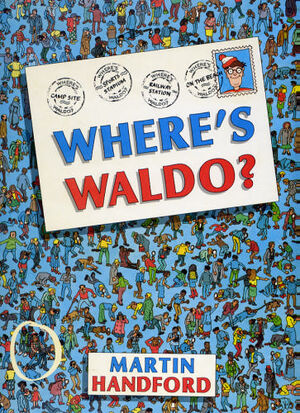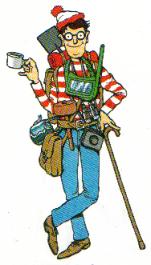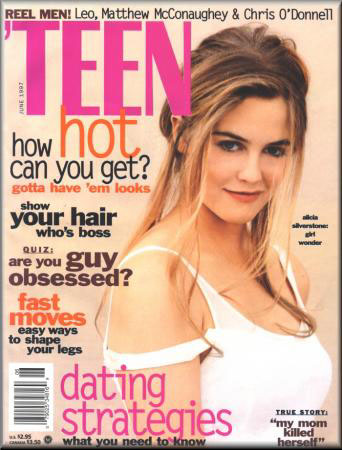Children of the 90s is taking care of some business...The blog will be back with some new posts later this week. Until then, please enjoy perusing this classic post on Where's Waldo back from March of '09. Thanks, everyone, and we'll be back soon!

Oh, Waldo, how you continue to thwart our valiant search efforts. Despite your obvious penchant for flamboyantly candy cane striped red and white sweater/hat combos and your tendency to take along every possible piece of travel equipment on your obscenely crowded vacations, you still manage to boggle our minds with your mysterious whereabouts. In the original book, Waldo lugs along a walking stick, sleeping bag, mallet, drinking cup, binoculars, kettle, backpack, camera, snorkel, belt, another bag, and a shovel. Clearly, if he's going get lost in a crowd, he's got every imaginable amenity to walk, sleep, pound, drink, see, boil, carry, document photographically, dive, remain in pants, store more items, or dig his way out. That's right, it makes perfect sense.

Where's Waldo? originated as a British franchise under the name "Where's Wally?" Apparently, "Wally" is some sort of a British slang term that publishers feared would drive away eager young American Waldo-searchers with its distinctively red-coat recalling familiarity, so the only logical leap was to change the title to an equally unknown and unpopular name that in no way resonated with American youth. In our typical domineering American fashion, we pulled the rug from under the British Wally and U.S. Waldo sales quickly and consistently outstripped sales of the original. If that's not a legitimate way to assert our undeserved sense of national superiority, I don't know what is.
With "Waldo-mania" sweeping the country throughout the 1990s, there seemed to be no one without vested stake or interest in finding this bespectacled excursionist. There was something oddly if inexplicably satisfying about curling up with a big hardcover picture book and focusing on crowded, chaotic scenes until your eyes crossed. It wasn't just Waldo we were after, either; he brought with him a gang of of absurd cronies and/or nemeses. There was Wanda, Waldo's pal. Woof, his faithful canine companion. After that is where things got a bit weird.
There was Wizard Whitebeard, some sort of life coach/guru who was occasionally responsible for sending Waldo on his wacky expeditions. Then of course we had Odlaw, Waldo's bizarrely evil nemesis formulated from an inverted anagram of Waldo's name. He was nearly identical to the original Waldo only his clothing and glasses were of different colors, and he has a mustache. Even as children, we were aware that mustaches signified pure, unfettered evil (there was Hitler, Stalin, and Odlaw, and we were onto their mustachioed madness). We the readers were forced to infer that Odlaw was evil by his distinctive un-Waldoness, despite the fact that we never actually caught him doing anything more than lurking in the background.

And of course, there were the Waldo Watchers, because what bumbling vacationer would travel anywhere without their 25-member posse of lookalike devotees? That's right, Waldo had an entourage. These are clearly a cheap attempt by the authors to divert our eyes with Waldo-esque color patterns and hat-stylings, but were we really to believe that by the mid-90s Waldo had 100 faithful followers who joined him on every venture?
 Silly characters aside, there were reasons that Waldo books held the top spot on the New York Times' bestseller list for a composite nearly-100 weeks. If nothing else, the books placated our parents with their hypnotizing ability to keep us unmovingly focused in a single spot for an extended period of time. Waldo had it all: books, comic books, cereal boxes, a short-lived magazine (with an impressive 2 issue run!), video games, and even a TV show. However, the plot-rich TV shows with only brief frozen-screen finding games interludes were never quite enough to hold our attention in the same way.
Silly characters aside, there were reasons that Waldo books held the top spot on the New York Times' bestseller list for a composite nearly-100 weeks. If nothing else, the books placated our parents with their hypnotizing ability to keep us unmovingly focused in a single spot for an extended period of time. Waldo had it all: books, comic books, cereal boxes, a short-lived magazine (with an impressive 2 issue run!), video games, and even a TV show. However, the plot-rich TV shows with only brief frozen-screen finding games interludes were never quite enough to hold our attention in the same way.Despite the dozens of poorly-conceived franchising paths, the Where's Waldo? books were nothing less than a phenomenon. So long as we could continue our relentless searches for our beloved hero, all was right in the world. Like most 90s trends for children, the allure was not in the flashy effects or superfluous characters, but rather in the simplicity and forthrightness of the task at hand. There is just no recapturing the magic of the moment of actually locating Waldo himself amidst a sea of impostors and villains.
So whether you grew up searching for Wally (UK) or Waldo (US), Valli (Iceland) or Walter (Germany), Effie (Israel) or Charlie (France), we were united in our common goal. No matter what you called him or where you lived in the world, we all knew Waldo as the greatest hidden holidayer of them all.












